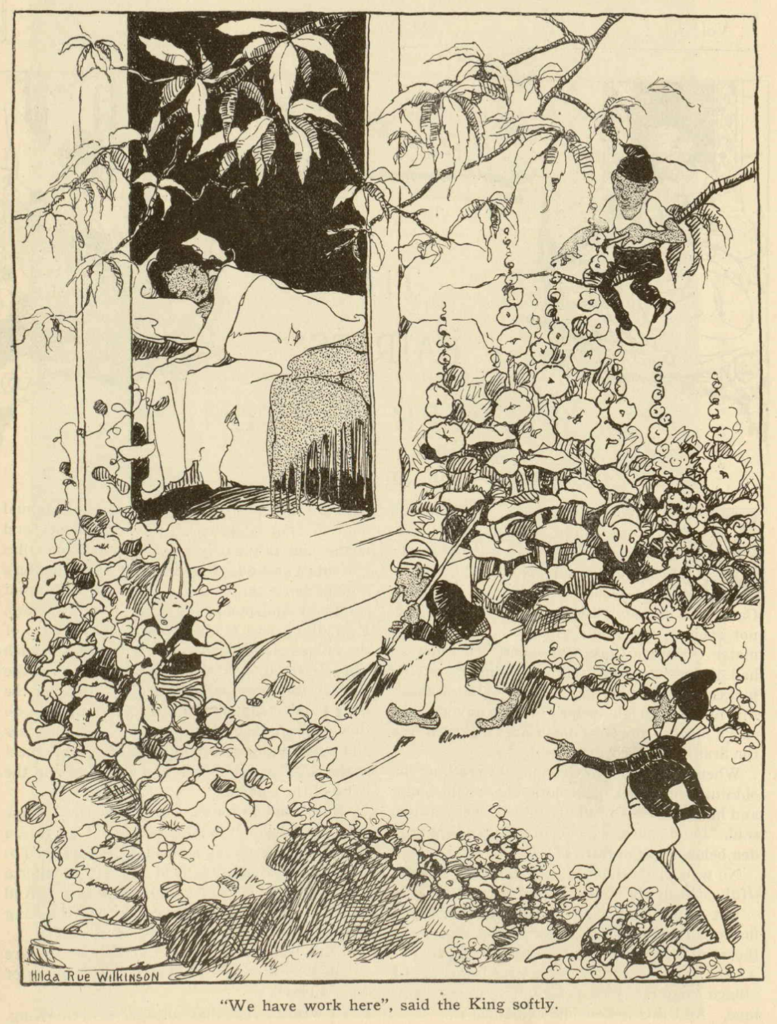The Fairies’ Flower Garden
By Grace White
Annotations by Catherine Bowlin

GRANDMA CAREY, a little, old, white-haired lady of the village, had the most beautiful flower garden of all. No one had flowers to bloom as early as Grandma Carey and nobody’s lived as long; and no one, not even in the whole village, had flowers to match Grandma Carey’s in color. Her flowers had the richest hues, her rambling roses, the pinkest tint, and her pansies were almost dazzling in their bright color. When anyone was sick a flower from Grandma Carey’s garden was the first aid to recovery.
When visitors asked Grandma Carey how she obtained such glorious colors, she would laugh and her little eyes would twinkle merrily as she said, “Land sakes, I don’t do nothin’; that garden belongs to the fairies!”
No wonder Grandma Carey had such a beautiful garden, the fairies lived there!
But soon there came a morning when the flowers didn’t hold up their heads, but hung them in shame. What could have happened? All the children and even the grown-ups of the village came hurrying to Grandma Carey’s cottage. And this is how she explained it.
For a long, long time the fairies had been planning and preparing for the Queen’s annual dance. They collected all the sweet honey and nectar and all the bright golden pollen for miles and miles around. For this year at the Queen’s annual dance they were to entertain with great ceremony and pomp, the King of the Gnomes. Everything was ready, from the sweet food of the fairies to the beautiful fairy carriages which were driven by golden-winged beetles. And the King of the Gnomes didn’t arrive! Imagine the anger and disappointment of the fairies! So they neglected their homes, (which are the roses and pansies and nearly all the flowers), to meet at the fairy palace to talk and wonder about the King of the Gnomes.
“But,” said Grandma Carey, slowly, “I know why the King of the Gnomes didn’t arrive on time. While crossing a meadow he happened to notice a tiny, neglected field and in the center a tiny, neglected cottage standing all alone. And it looked so forlorn and forgotten that the King of the Gnomes expressed a desire to visit it.
“‘But,’ said the Count of the Gnomes, ‘we are on our way to visit Her Majesty, The Queen of the Fairies!’
“‘I wish to visit that cottage,’ said the King, ‘and I shall do so.’
“And so the King of the Gnomes visited the forlorn looking cottage. If one would call the outside forlorn, one should see the inside, that was most forlorn! For on a cot in the corner of the room lay a little girl moaning and tossing in pain, crying always, incessantly for flowers, bright flowers.

“‘We have work here,’ said the King softly. ‘Let us begin.’ So all the King’s men started to work and they worked harder and harder. Now when one works hard one accomplishes something; and the King’s men really did accomplish something. For the next morning the little field around the cottage was cleared of its rubbish and weeds and in their place grew beautiful, bright flowers! Imagine the surprise and joy of little Margaret Marnie when she saw her lovely garden!
“And so today when the King left, Margaret Marnie was sitting on the steps softly talking and caressing her bright flowers. Margaret Marnie was well again. Now,” continued Grandma Carey, “the King of the Gnomes is on his way to visit the Queen of the Fairies and when he arrives the Queen will forget her temper. The King will apologize and all will be peace again. For the King of the Gnomes is going to ask for the Queen’s hand in marriage and I think she will accept. Their honeymoon will be spent visiting Margaret Marnie’s garden, then they will come back to live forever in my garden. When they do, then my flowers will become beautiful again.”
Thus Grandma Carey ended her story. Yes, even as she spoke the flowers raised their heads; their color returned, the King of the Gnomes had arrived.
Once more Grandma Carey had the most beautiful garden of all. And strange to say, Grandma Carey’s flowers never lost their bloom again, and so we conclude that the King of the Gnomes and the Queen of the Fairies are living very happily in their beautiful garden of flowers.
White, Grace. “The Fairies’ Flower Garden.” The Brownies’ Book, ed. W. E. B. Du Bois, vol. 1, no. 5, New York, N.Y.: DuBois and Dill, May 1920. 131-133. Retrieved from the Library of Congress, <www.loc.gov/item/22001351/>.
Contexts
Racial uplift is the ideology that educated Black people are responsible for the welfare of the majority of the race. This ideology describes a prominent response of Black middle-class leaders, spokespersons, and activists to the crisis marked by the assault on the civil and political rights of African Americans primarily in the U. S. South from roughly the 1880s to 1914.
Resources for Further Study
- For an analysis of fairies in The Brownies’ Book, see Fern Kory’s article, “Once Upon a Time in Aframerica: The ‘Peculiar’ Significance of Fairies in the Brownies’ Book” in the 2001 volume of Children’s Literature. Full citation for this source: Kory, Fern. “Once upon a Time in Aframerica: The “Peculiar” Significance of Fairies in the Brownies’ Book.” Children’s Literature, vol. 29. (2001): 91-112. ProQuest, https://login.libproxy.uncg.edu/login?url=https://www.proquest.com/docview/195575070?accountid=14604.
- See also the section “Fairies in The Brownies’ Book as Symbols of Assimilationism” from Amanda Ashley Jones’s history thesis, With a Sprinkle of Fairy Dust and a Splash of Color, in which the author discusses fairies as symbolic of assimilationism in the racial uplift movement.